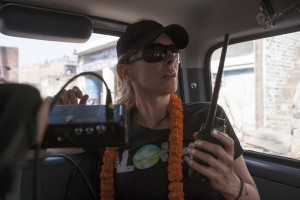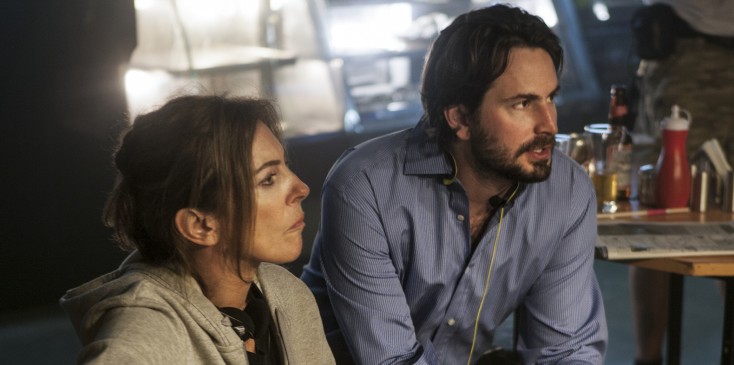
Director/Producer Kathryn Bigelow on the set of Columbia Pictures’ thriller “ZERO DARK THIRTY.” ©Columbia Pictures. CR: Jonathan Olley.
By ANGELA DAWSON
Front Row Features
HOLLYWOOD—Kathryn Bigelow is in an elite category. She is the first woman to win an Academy Award for directing a feature film—that film being 2008’s war drama “The Hurt Locker.” (She also picked up a statue for producing that film.)
Bigelow reteams with “Hurt Locker’s” Academy Award winning screenwriter Mark Boal to tackle yet another extraordinary U.S. defense operation, the long and frustrating hunt for and ultimate capture of Osama bin Laden, in “Zero Dark Thirty.” The title is a military reference to the dark of night, which was the time when the secret Navy SEALs mission took place. A small but well-trained unit stormed the terrorist leader’s residence in Pakistan and took him out in 2011. The story is told through the eyes of a young, tenacious CIA agent (portrayed by “The Help’s” Jessica Chastain) who tracked the elusive mastermind for years, finally discovering his hiding place, through a variety of intelligence sources. Though based on a real person, her name, as well as that of others depicted in the film, was changed to protect her identity.
The 61-year-old filmmaker recently spoke about making “Zero Dark Thirty” and the unique challenges the drama posed for her and her cast and crew.
Q: It must be very gratifying to become an Academy Award winner and have everyone anticipating your next movie and assuming it’s going to be good.
Bigelow: I am just so gratified that “The Hurt Locker” received a certain amount of attention. I am so honored about that. It was a very surprising experience, but also just so gratifying.
Q: We heard the news about how one of the Navy SEALs. who was part of this operation, was killed in another rescue mission today in Afghanistan. Obviously, this film is about him and his squad, and what they did last year. Do you have any thoughts about him and the fact that the SEALs are still putting their lives on the line?
Bigelow: It’s a tragedy. It’s a real tragedy.
Q: Doing a film of this sensitive nature, was there any concern for your own personal security in revealing certain things?
Bigelow: No.
Q: It’s been reported that you checked with the Pentagon to get the details right. For example, you sent them pictures of the helicopters you used to make sure they were close to reality. How else did the military assist you?
Bigelow: DOD didn’t vet the screenplay. Had we gone down that road, we might have had a lot more assets available to us, but I think it was a very smart decision on Mark (Boal’s) part to work off his material and to not have that extra layer imposed on him.
Q: Can you talk about the difficulty of doing a film that so many people know so many aspects about, especially the outcome?
Bigelow: Yeah, well, certainly it doesn’t lend itself to spoilers. (She smiles.) What was so strong and what struck me so much about the screenplay was how inherently dramatic that 10-year journey was. It was a riveting, galvanizing story that gave us a real glimpse at the intelligence hunt on the ground, through the eyes of the characters that Jessica and Jason (Clarke, who plays an interrogator) play. (It’s about) what it would be like to hunt the world’s most dangerous man: the dedication, the courage, the sacrifice and the price they pay, and some of their colleagues, who didn’t survive. It was inherently a very dramatic piece, and the fact that you know the ending only amplified the drama.
Q: You’re a female director in a male-dominated profession, but you’ve shown that women can do the job in action movies like this. Similarly, the CIA is a male-dominated profession, and this film shows a female agent doing a really good job, so was that part of the attraction for you to direct this?
Bigelow: If the character at the center of the hunt had been a man, I would have been very happy and eager to engage in that story as well. What’s important to me is that she’s a strong character. The movie doesn’t engage necessarily in gender politics. She is not defined by a man. She is not defined by a love interest. She is defined by her actions. And I think that’s a character that’s very inspiring and beautifully played by Jessica. I will say that I was surprised and excited that it was a woman at the center of this hunt, but there are also a lot of men who worked very, very hard as well. It was a very wonderful screenplay, so I was very happy.
Q: What was the discussion beforehand about showing the interrogation scenes, which are pretty disturbing? Was there a thought of not including them because the subject is such a political hot button?
Bigelow: It was difficult to shoot those sequences. I wish it was not a part of our history, but it was.
Q: Can you talk about how you worked with your creative team to create the look and the tone of the film?
Bigelow: I had an extraordinarily talented crew, including our cinematographer Greg Frazier, an Australian, Jeremy Hindle our production designer, Paul Ottoson, our sound designer, Alexandre Desplat, our composer and both William Goldenberg and Dylan Tichenor were the editors. It was very important to us to really give the audience a sort of “you are there” feel with this piece. In other words, to kind of peel back the curtain of the intelligence hunt and get a glimpse of what it might be like to actually try to find a very sharp needle in a very big haystack, and to do it in a way that sort of feels like it’s unfolding in real time in front of you, around you and you are inside it, especially with the raid itself.
Q: What was the toughest scene to shoot?
Bigelow: The raid was the most challenging, logistically, because we had to shoot in low light conditions to replicate a moonless sky and then no-light conditions to use the night vision goggles, which were real night vision lenses that we adapted to our camera lenses. So we had about 100 crewmembers and 22 (actor) SEALs traipsing around a pitch black, rubble-strewn set, and it was kind of interesting. But again, the desire was to make it feel kind of “you are there.” It wasn’t a subjective camera (viewpoint), but we wanted to make it feel real and that it’s unfolding around you in real time.
Q: How did Jessica handle this from beginning to end?
Bigelow: It’s such a testament to an extraordinary talent that Jessica is that she had to find the highly beautiful and nuanced and subtly calibrated emotion of her character. For instance, in a scene where she is delivering lines like 20 detainees confirmed, it’s just so highly nuanced and carefully calibrated in a very narrow bandwidth of opportunity. There is not an opportunity to go out to a bar and hang out with her friends. All that has to come out of this very sort of story-rich format, and it’s just a real testament to her talent that she could do it.
Q: How did you decide how much to show of bin Laden in the film?
Bigelow: Our thinking was this is about the people, the men on the ground, the workforce who found this house and this man, and ultimately not really about him. They humanized that hunt and humanized that journey, and it’s their story.
Q: How did you decide which post-9/11 terrorist attacks to depict in the film?
Bigelow: This is something that Mark made very clear in the screenplay. Like, what’s at stake? Every day that goes by that they don’t find this man, there could be another 9/11. There could be another London bombing. There could be another (Islamabad) Marriott. (The film is) only two and a half hours, so there were events we didn’t have time (to depict), but what was important was to remind us of the ticking bomb.
Q: How did you film the Marriott bombing scene?
Bigelow: We just rigged a room like this. It took probably about two weeks. I found a location, and then we would rig the whole place so it was ready to go, and we had pulleys and knew where people would be thrown across the floor on harnesses. Every single window was rigged to go, and all the glass was replaced with tempered glass, so there was nothing dangerous on the set. There was a lot of planning and then you set it up and bring in the actors. That was one take and they were just perfect, perfect, perfect. It was intense, very intense, and it worked well.





